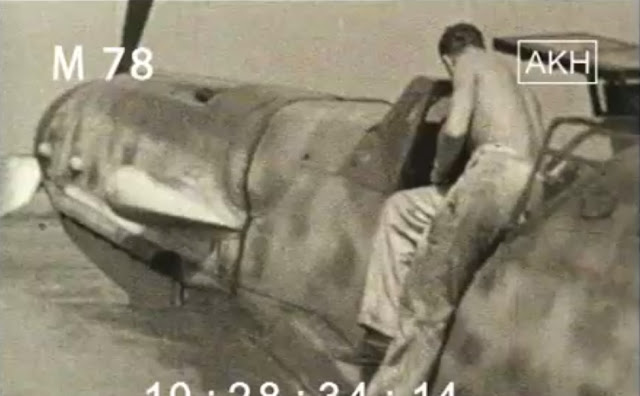The following stills were captured from footage made available via the Agentur Karl Höffkes film archive AKH and are reproduced here with the kind permission of Karl Höffkes.
On 21 July 1943, Jagdgruppe Süd der ObdL was formed as a high-altitude fighter unit to combat the RAF's Mosquito twin-engine bomber and reconnaissance aircraft. On 15 August 1943 the unit was redesignated Jagdgeschwader 50 and Maj. Hermann Graf, the first pilot in history to achieve 200 aerial victories, was appointed to command. Both JG 50 (and its sister unit Jagdgeschwader 25) were particularly unsuccessful in countering the Mosquito but enjoyed comparatively more success intercepting US heavy bomber formations during the daylight offensive over Europe in 1943-44.
Here Graf is seen arriving in Wiesbaden during June-July 1943 in his relatively anonymous Gustav - note the absence of any markings including Kennziffer. Interestingly the starboard wing shows evidence of a saw-tooth splinter finish, while the port wing does not. Graf's '202' Eichenlaub badge is seen aft of the Balkenkreuz.
Besuch von Gymnasiasten bei Maj. Hermann Graf, Jungen alle in HJ-Uniform, Graf startet, 16 September 1943, JGr. 50 Wiesbaden-Erbenheim, Reichsverteidigung.
Filmed on 16 September 1943 Graf entertains HJ schoolkids at Wiesbaden and treats them to a fly-past in his Bf 109 G-6 W.Nr. 15 919 (?) "Grüne 1" featuring red spinner and 'tulip' cowl markings and two Werfer rocket grenade launchers. Note what some have referred to as the outer Bf 109 K-style gear doors - which here may hve been trialed as simple blast protectors for the exposed tyre from the Werfer launch. These film clips expertly processed by Karl Höffkes also depict other members of Graf's new Reich's defence unit - particularly RK-Träger Ernst Süß and Alfred Grislawski.
RK-Träger Ernst Süß und Grislawski mit Kriegsberichtern
A good view of the wing upper surface camouflage on Grislawski's 'White 10' and the facilities on the base at Wiesbaden for those interested in these kinds of detail. Close-up view of the 'hunter' emblem and the white tail of Grislawski's '10'. Bottom, dismantling Grislawski's white rudder on the disbandment of JGr. 50.
JG 50 was initially equipped with eight Messerschmitt Bf 109 G-5s and Bf 109 G-6s polished to increase speed, and equipped with a special internal tank for liquefied nitrous oxide as part of the GM-1 engine power boosting system, which was injected directly into the supercharger intake. This allowed the pilot to boost the rated horsepower of the DB 605 engine. Graf was allowed to pick any pilots he wished for the new unit, and he chose a further three aces Oblt. Alfred Grislawski, Obfw. Ernst Süß (seen posing alongside Grislawski's 'white 10' in the pictures above), and Fw. Heinrich Füllgrabe from his old Staffel - the 9./JG 52.
JG 50 was the first formation to use the Werfer-Granate 21 rocket mortar 'operationally', with one carried under each wing. While these rockets could bring down a bomber with one hit, they were designed to disperse the tightly packed bomber formations rather than as a direct fire weapon. On 31 July 1943 the unit was declared operational, with a total of 19 aircraft. On 17 August 1943 the unit intercepted American bomber forces attacking the Messerschmitt factory in Regensburg and the ball bearing plants in Schweinfurt. Grislawski claimed two Boeing B-17 Flying Fortresses downed on this raid. On 6 September the unit's pilots shot down four Flying Fortresses over Stuttgart, one to Grislawski, and two claimed by Graf with the WfGr.21, who was then shot down but survived a forced landing. Grislawski claimed one other kill with the unit, a B-17 on 14 October. By October, JG 50 had been disbanded and merged with I. Gruppe, Graf was subsequently appointed commander of JG 11 in November 1943. Two of the so-called Karaya Quartet survived the war; Süß and Füllgrabe were killed in action.
















